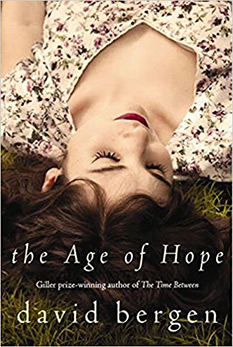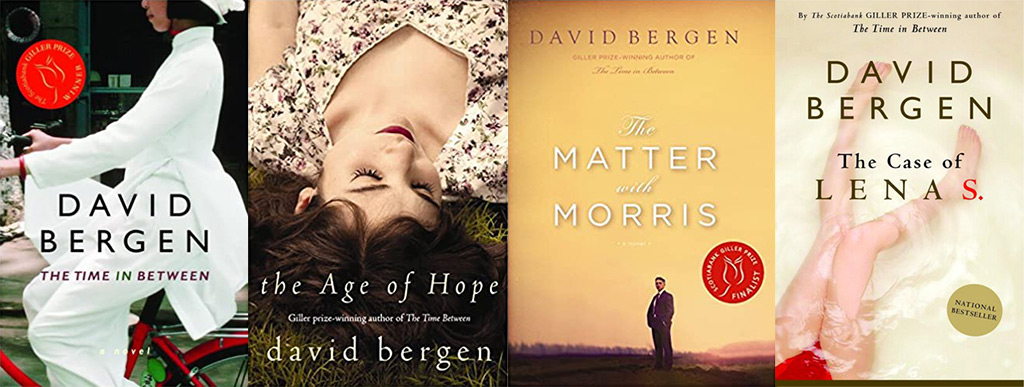The Age of Hope, David Bergen (Toronto: HarperCollins, 2012).

There are two things odd I note about this novel. One is that its author is a man writing a woman as the principal character. This is a risky thing to do, especially in this age of stay-in-your-lane identity politics, which often sees people crucified for straying even a little beyond the narrow strictures of verifiable personal experience. But a stay-in-your-lane approach to novel writing only makes sense if the function of creativity is solely to engage in an act of testimony: the novel as an expression of the author’s personal truth. I find it difficult to believe that David Bergen is writing his personal truth when he writes about a woman born in 1930 in a small Mennonite town in Manitoba who finds herself in that odd place between the role of a traditional wife and mother on one side and the autonomous personhood demanded by second wave feminism on the other side.
The novel is slyly self-conscious about what it might be as a book. We have this passage:
Hope knew that her thinking regarding books went contrary to the general sentiment of the people of Eden. Books were seen as a waste of time. What was the point, unless you were reading for information? To lose oneself in a book was to be slightly wacky, a little greedy, and ultimately slothful. There was no value. You couldn’t make money from reading a book. A book did not give you clean bathrooms and waxed floors. It did not put the garden in. You couldn’t have a conversation while reading. It was arrogant and alienated others. In short, those who read were wasteful and haughty and incapable of living in the real world. They were dreamers.
There is a certain congruence between the view held by the townsfolk of Eden and today’s prevailing stay-in-your-lane account of fiction. Fiction as an expression of the author’s personal truth is a pragmatic justification not that different than the pragmatic demand that there be profit in the act of reading. The only difference is that one is a form of monetary profit and the other envisions a form of moral profit. The temptation is to join forces with the townsfolk and judge Bergen’s novel by the extent to which it produces a profitable reading experience which in today’s parlance, can be framed as the extent to which he offers an authentic portrayal. Did this man get the woman right? Is it realistic? Is it emotionally true?
The second odd thing I note about The Age of Hope is that it offers up an utterly ordinary life. A girl grows up in a small Manitoba town. Although the community is overwhelmingly Mennonite, her own parents are neither too strict nor too relaxed. This is not Miriam Toews, so we lack the sharply drawn drama that strict authoritarian figures produce. She falls for an unremarkable boy named Roy Koop. At the novel’s outset Bergen signals that although remarkable paths are possible, they will be foreclosed to Hope. As a teenager, she had it sweet for a boy named Jimmy Kaas but he killed himself when he crashed a light plane after buzzing Hope’s house. That is the novel’s most dramatic event and it’s over and done in the first sentence. Instead, Hope settles down with Roy who develops a successful car dealership. She has four children who face many of the usual challenges.
The greatest drama here may well rest in Hope’s struggle to discover if she is a person in her own right or merely by her roles as wife and mother. She becomes depressed, ends up in a hospital, has ECT treatments, and gradually emerges from her fog and general passivity. When the children are grown, interest rates hit 22% and, because Roy can no longer service his business credit, the bank forecloses on him. Roy and Hope move into a small Winnipeg apartment. Roy dies unexpectedly and an insurance policy leaves Hope modestly comfortable as she drifts into old age.
Bergen attends not to the drama but to the interstitial spaces between dramatic moments. He was more explicit about this in his earlier novel, as we can gather from its title, The Time In Between. Bergen investigates what transpires in those less obvious moments, the times when we wait, when we waver in uncertainty, when we recover from illness, or when we quietly discern our next steps.
In a way, Bergen is the perfect author to read during a pandemic lockdown. History may record the Covid-19 global pandemic as a dramatic crisis worthy of its own straight-to-Netflix movie. But sitting here in the midst of it, I experience it not so much as a crisis as I do a chronic state to be endured. It is an interstitial time between life before and life after. We need people like Bergen to teach us how to live in this down time as we wait our turn for a dose of vaccine and the chance to spend time again with family and friends.
